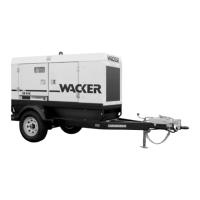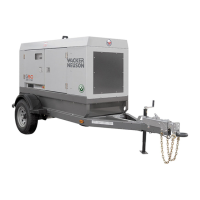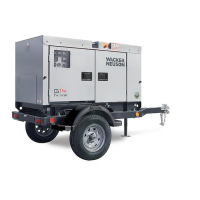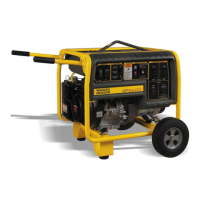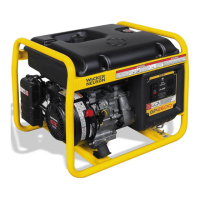Theory of Operation Mobile Generator
wc_tx001077gb.fm 18
2.3 Terminology
See Graphic: wc_gr003315
To understand the terms “phase”, “leg”, “line-to-line”, and “line-to-
neutral”, review the following information.
• The main stator (a) consists of three separate groups of windings.
These groups of windings are referred to as legs. The legs are
labeled L1, L2, and L3. Each leg includes two individual windings. The
ends of these windings are labeled T1, T2, T3, and so on, up to T12.
• Each individual winding has the same resistance (0.2 Ohms). The
voltage selector switch determines how the windings are connected—
in series or parallel. In series, the total voltage of a leg is equal to the
sum of the voltages induced across both windings. In parallel, the
total voltage of a leg is equal to the voltage induced across either
winding (only one).
• Each leg (L1, L2, and L3) is physically 120° from each other.
• The main rotor (b) functions as a rotating magnetic field. It has four
poles, two of which function as North and the other two as South.
• “Flux” is a term used to describe the amount of magnetic field in a
given area. The term “lines of flux” refers to the direction of the attrac-
tion of the magnetic fields—North to South. The point where these
lines of flux are closest to 90° is the point where the magnetic field is
the strongest, i.e., at either pole. The lines of flux (c) of the main
rotor’s magnetic field are as shown. When the windings of the stator
cut these lines of flux, voltage is induced in them. The amount of
induced voltage is greatest at the position where the stator winding is
perpendicular to the lines of flux, i.e., when the rotor is in such a posi-
tion that the windings of a leg are centered over one of the four mag-
netic poles.
• When the two windings of each leg are connected in series, this is the
high-wye configuration (e). The voltage induced in this configuration is
277V per leg. When the two windings of each leg are wired in parallel,
this is the low-wye configuration (f). The voltage induced in this con-
figuration is 139V per leg. (It is adjusted to a usable 120V by the con-
trol panel rheostat.)
• The amount of voltage induced in each leg over time can be graphed.
This graph yields a sine wave (d). It represents the repeating event
(cycle) of the induced positive voltage of the North pole followed by
the induced negative voltage of the South pole. Since the rotor has
four magnetic poles, this cycle occurs twice per revolution of the rotor.
• The engine spins the rotor at 1800 rpm which equals 30 revolutions
per second (rps) (1800 ÷ 60 = 30). The number of revolutions per sec-
ond multiplied by the cycles per revolution (cpr) equals the cycles per
second (Hertz). Thus, 30 rps x 2 cpr = 60 Hz.
